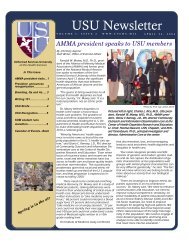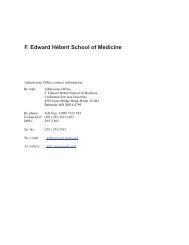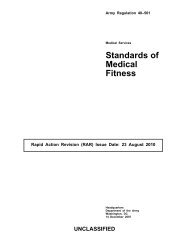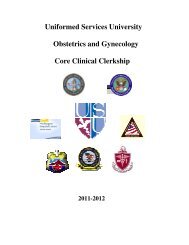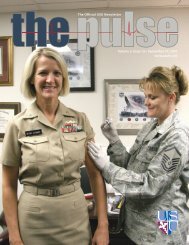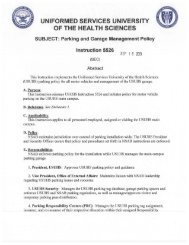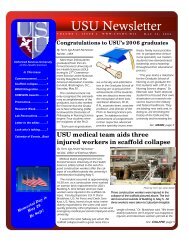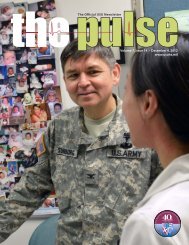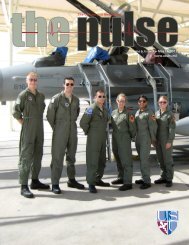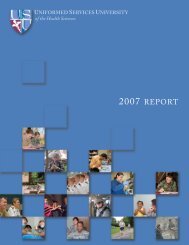666<strong>Muscle</strong> <strong>strength</strong> <strong>and</strong> movement pattern <strong>differences</strong>Table 2. Number of subjects scor<strong>in</strong>g an error for each factor 1,2 .Male(N=1707)Fe<strong>male</strong>(N=1046)Factor N % N %Factor 1 Poor Sagittal Flexion – Stance 559 32.8% 448 42.6%Factor 2 Valgus Knee & Feet Too Wide 428 25.1% 386 36.7%Factor 3 Toes Out & Knees Flexed 503 29.5% 154 14.6%Factor 4 Heelstrike & Uneven Footstrike 751 44.1% 273 26.0%Factor 5 Poor Sagittal Flexion – L<strong>and</strong><strong>in</strong>g 582 34.1% 472 44.9%1 Factors generated from factor analysis load<strong>in</strong>g. 2 For items 1-15, a positive score was def<strong>in</strong>ed as an Error onat least 2 of 3 trials. For items 16 & 17, a positive score was def<strong>in</strong>ed as Average on at least 2 of 3 trials orPoor/ Stiff on at least 1 of 3 trials.showed that <strong>male</strong>s <strong>and</strong> fe<strong>male</strong>s were significantly differentfor all <strong>in</strong>vestigated anthropometric (height, weight,BMI, navicular drop, <strong>and</strong> Q-angle) <strong>and</strong> <strong>strength</strong> variables(Tables 3 <strong>and</strong> 4).Table 3. Subject biometrics. Data are means (±SD).Males(n = 1,607)Fe<strong>male</strong>s(n = 994)Height (m) 1.78 (.07) 1.66 (.07) *Weight (kg) 77.4 (12.3) 63.0 (7.8) *Body Mass Index 24.3 (3.1) 22.9 (2.3) *Navicular Drop (mm) 7.5 (2.8) 7.0 (2.6) *Q-Angle (º) 8.6 (4.5) 11.6 (4.9) ** p < 0.001Table 4. <strong>Muscle</strong> <strong>strength</strong> normalized to body mass (N·kg -1 ).Data are means (±SD).Males(n = 1,607)Fe<strong>male</strong>s(n = 994)Quadriceps .49 (.09) .41 (.09) *Hamstr<strong>in</strong>gs .24 (.05) .21 (.05) *Hip external rotation .21 (.04) .17 (.03) *Hip <strong>in</strong>ternal rotation .19 (.04) .18 (.04) *Gluteus maximus .26 (.07) .23 (.07) *Gluteus m<strong>in</strong>imus .34 (.08) .30 (.07) ** p < 0.001Predict<strong>in</strong>g poor l<strong>and</strong><strong>in</strong>gDue to miss<strong>in</strong>g data values, univariate <strong>and</strong> multivariateregression models were analyzed for 2,734 participants(fe<strong>male</strong>s = 1046; <strong>male</strong>s = 1688). Univariate analysis for<strong>male</strong>s <strong>in</strong>dicated that low BMI, <strong>in</strong>creased Q-angle, <strong>and</strong>poor gluteus medius <strong>strength</strong> were <strong>in</strong>dividually predictiveof poor l<strong>and</strong><strong>in</strong>g technique (higher LESS score). Howeveras a group, multivariate modell<strong>in</strong>g showed extremelylimited predictive value (comb<strong>in</strong>ed R 2 =.016; p < 0.01)<strong>and</strong> only lower BMI <strong>and</strong> weak hip <strong>in</strong>ternal rotation<strong>strength</strong> significantly contributed to poorer l<strong>and</strong><strong>in</strong>g technique(Table 5). For fe<strong>male</strong>s, univariate analyses suggestedthat weaker hamstr<strong>in</strong>gs <strong>and</strong> weaker gluteus medius<strong>strength</strong> were important predictors of poorer <strong>jump</strong>-l<strong>and</strong><strong>in</strong>g(Table 6). However, <strong>in</strong> contrast to <strong>male</strong>s, we were notable to strongly predict specific contributors to l<strong>and</strong><strong>in</strong>gerror <strong>in</strong> fe<strong>male</strong>s with multivariate analysis (p = 0.098).Aga<strong>in</strong>, the predictive value of all these variables as agroup was very limited (comb<strong>in</strong>ed R 2 = 0.014).DiscussionMovement pattern <strong>differences</strong> can be assessed by theLESSThe ability to quickly <strong>and</strong> reliably identify <strong>in</strong>dividuals athigh risk of <strong>in</strong>jury is critical to <strong>in</strong>jury prevention efforts.Because high-risk movement patterns have been l<strong>in</strong>ked toACL <strong>in</strong>jury risk (Hewett et al., 2005; Krosshaug et al.,2007), the ability to rapidly screen for these movementpatterns could facilitate the implementation of large-scale<strong>in</strong>jury prevention efforts. Our results <strong>in</strong>dicate that a <strong>qualitative</strong>movement screen, the L<strong>and</strong><strong>in</strong>g Error Scor<strong>in</strong>g System(LESS) can accurately characterize the <strong>jump</strong>-l<strong>and</strong><strong>in</strong>gcharacteristics of a large cohort of <strong>male</strong>s <strong>and</strong> fe<strong>male</strong>s.Fe<strong>male</strong>s demonstrated poorer overall l<strong>and</strong><strong>in</strong>g technique(5.34 ± 1.51 vs. 4.65 ± 1.69 for <strong>male</strong>s) <strong>and</strong> showed lessknee flexion, less hip flexion <strong>and</strong> more valgus collapse.These results are similar to studies of common movementtasks us<strong>in</strong>g traditional laboratory biomechanics (Chappellet al., 2002; Hewett et al., 2006; Mal<strong>in</strong>zak et al., 2001;Padua et al., 2009). Previous work has shown that LESSscore is correlated with high-risk movement patterns asmeasured by traditional motion analysis (Padua et al.,2009). Taken together these results suggest that the LESSaccurately characterizes <strong>jump</strong>-l<strong>and</strong><strong>in</strong>g movements. Theresults of the present <strong>in</strong>vestigation do not allow us todeterm<strong>in</strong>e which <strong>differences</strong> are specifically correlatedTable 5. Univariate <strong>and</strong> multivariate regression results – Males.Univariate 1 Multivariate 1Variable β SE t-value p-value β SE t-value p-valueBMI -.091 .321 -3.77
Beutler et al. 667Table 6. Univariate <strong>and</strong> multivariate regression results – Fe<strong>male</strong>s.Univariate 1 Multivariate 1Variable β SE t-value p-value β SE t-value p-valueBMI -.024 .020 -.77 .44 -.040 .022 -1.22 .22Q-Angle .026 .010 .85 .40 .020 .010 .64 .52Navicular Drop -.017 .018 -.57 .57 -.020 .018 -.65 .52Quadriceps -.011 .554 -.36 .72 .045 .722 1.11 .29Hip Ext. Rotators -.023 1.426 -.73 .47 .041 1.931 .97 .33Hip Int. Rotators -.052 1.264 -1.70 .09 -.026 1.822 -.58 .57Hamstr<strong>in</strong>gs -.067 1.008 -2.17 .03 * -.070 1.387 -1.65 .10Gluteus Maximus -.005 .717 -.18 .86 .031 .786 .91 .37Gluteus Medius -.081 .646 -2.6 .01 -.094 .847 -2.32 .02 ** Statistically significant. 1 Univariate betas are not adjusted for any other variable; multivariate betas are adjusted forany other variables listed <strong>in</strong> the table.with an <strong>in</strong>creased risk of <strong>in</strong>jury. The error of measurementfor the LESS score is greater than observed gender <strong>differences</strong>,suggest<strong>in</strong>g that <strong>in</strong>dividual variability may limit thepredictive capacity of the LESS. However, the ability ofthe LESS to predict <strong>in</strong>jury <strong>in</strong> the military academy populationis an area of ongo<strong>in</strong>g study.Implications for <strong>in</strong>jury risk based on L<strong>and</strong><strong>in</strong>g ErrorPatternsWhile s<strong>in</strong>gular aspects of <strong>jump</strong>-l<strong>and</strong><strong>in</strong>g technique contributeto high-risk l<strong>and</strong><strong>in</strong>gs, it is possible that a comb<strong>in</strong>ationof multiple factors is more predictive of overall risk.We were able to determ<strong>in</strong>e common l<strong>and</strong><strong>in</strong>g-error patternsfor fe<strong>male</strong>s <strong>and</strong> <strong>male</strong>s us<strong>in</strong>g factor analysis. Strik<strong>in</strong>gly,each error pattern detected has been suggested <strong>in</strong>previous literature to contribute to ACL <strong>in</strong>jury: 1) decreasedsagittal flexion at <strong>in</strong>itial ground contact (Chappellet al., 2007); 2) valgus knee (Ford et al., 2003; Hewett etal., 1999; 2005) <strong>and</strong> feet wide at <strong>in</strong>itial contact; 3) toesout <strong>and</strong> knees flexed at <strong>in</strong>itial contact (DiStefano et al.,2009); 4) heelstrike l<strong>and</strong><strong>in</strong>g <strong>and</strong> asymmetric footstrikel<strong>and</strong><strong>in</strong>g (Boden et al., 2009); <strong>and</strong> 5) lack of sagittal flexionover the l<strong>and</strong><strong>in</strong>g (Chappell et al., 2007). While both<strong>male</strong> <strong>and</strong> fe<strong>male</strong> cadets exhibited these comb<strong>in</strong>ations ofhigh-risk movement, clear gender tendencies towardsdifferent patterns were detected (Table 2). Similar toprevious reports, 42.6% of fe<strong>male</strong>s <strong>in</strong> our cohort exhibitedshallow sagittal flexion angles (trunk, hip, <strong>and</strong> knee) atground contact (Factor 1) <strong>and</strong> 44.9% demonstrated poorknee flexion displacement over the entire l<strong>and</strong><strong>in</strong>g phase(Factor 5). These flexion faults <strong>and</strong> propensity towardsvalgus dur<strong>in</strong>g l<strong>and</strong><strong>in</strong>g are consistent with many prior<strong>in</strong>vestigations (Chappell et al., 2002; 2007; Colby et al.,2000; Mal<strong>in</strong>zak et al., 2001). In contrast to these f<strong>in</strong>d<strong>in</strong>gs,a recent study reported fe<strong>male</strong>s had <strong>in</strong>creased knee flexionat the time of ACL <strong>in</strong>jury versus <strong>male</strong>s (Krosshaug etal., 2007). However, knee <strong>and</strong> hip flexion may be taskdependent,which may expla<strong>in</strong> the differ<strong>in</strong>g results.We also found that fe<strong>male</strong>s were more likely than<strong>male</strong>s to l<strong>and</strong> with an excessively wide stance <strong>in</strong> comb<strong>in</strong>ationwith knee valgus (Factor 2). This has not beenpreviously reported <strong>in</strong> traditional biomechanical <strong>in</strong>vestigations.This wider l<strong>and</strong><strong>in</strong>g stance may represent an adaptiveprecursor to subsequent valgus collapse, or it maysimply reflect a wider average pelvic width <strong>in</strong> fe<strong>male</strong>cadets. We are directly measur<strong>in</strong>g pelvic width <strong>in</strong> anongo<strong>in</strong>g study. Analysis of that data may allow us tobetter describe the phenomenon of wide l<strong>and</strong><strong>in</strong>g stance <strong>in</strong>fe<strong>male</strong>s.Males exhibited different l<strong>and</strong><strong>in</strong>g-error patternsthan fe<strong>male</strong>s. The most common <strong>male</strong> factor was heelstrikel<strong>and</strong><strong>in</strong>g/uneven footstrike dur<strong>in</strong>g l<strong>and</strong><strong>in</strong>g (Factor 4),which occurred <strong>in</strong> 44.1% of our <strong>male</strong> population. Maleswere also more likely than fe<strong>male</strong>s to l<strong>and</strong> with “toes-out”(tibial external rotation) (Factor 3). These <strong>male</strong> errorpatterns have only recently been reported (Boden et al.,2009; Krosshaug et al., 2007) <strong>and</strong> are less familiar, perhapsless understood than fe<strong>male</strong> themes. While cadaveric<strong>and</strong> biomechanical modell<strong>in</strong>g studies suggest that ACLstra<strong>in</strong> is greater with knee <strong>in</strong>ternal rotation, analyses ofactual <strong>in</strong>jury mechanism describe an external rotatoryforce on the knee, suggest<strong>in</strong>g this position is <strong>in</strong>deed highrisk(Shimokochi <strong>and</strong> Shultz, 2008). The effects ofasymmetric foot strike <strong>and</strong> a heels-first l<strong>and</strong><strong>in</strong>g are lessdiscussed <strong>in</strong> ACL <strong>in</strong>jury literature. One possible implicationcomes from prelim<strong>in</strong>ary work by Boden <strong>and</strong> colleagueswho propose that a flat-foot l<strong>and</strong><strong>in</strong>g reduces theability of the calf muscles to dampen the ground reactionforces before they reach the knee (Shimokochi <strong>and</strong>Shultz, 2008).Predict<strong>in</strong>g poor l<strong>and</strong><strong>in</strong>gIn addition to classify<strong>in</strong>g common patterns of movement,we attempted to identify relationships between measuredanthropometric <strong>and</strong> <strong>strength</strong> elements <strong>and</strong> observed l<strong>and</strong><strong>in</strong>gmovement patterns. In the univariate analysis of <strong>in</strong>dividualvariables, our results suggest that low BMI contributesmore to <strong>jump</strong>-l<strong>and</strong><strong>in</strong>g movements <strong>in</strong> <strong>male</strong> cadetsthan <strong>in</strong> fe<strong>male</strong> cadets. The relationship between this f<strong>in</strong>d<strong>in</strong>g<strong>and</strong> previous reports of higher BMI be<strong>in</strong>g associatedwith <strong>in</strong>creased <strong>in</strong>jury <strong>in</strong> military <strong>and</strong> other populations isunclear (Jones et al., 1986; Knapik et al., 1991; Uhorchaket al., 2003). One possible explanation is that fatiguecould preferentially worsen movement patterns <strong>in</strong> thosewith high BMI. Future studies compar<strong>in</strong>g movementpatterns under fatigued <strong>and</strong> non-fatigued conditionswould facilitate further analysis. We also found that hiprotator <strong>strength</strong> exerts m<strong>in</strong>imal <strong>in</strong>fluence on poor l<strong>and</strong><strong>in</strong>gtechnique <strong>in</strong> either gender. This appears to contrast withrecent th<strong>in</strong>k<strong>in</strong>g <strong>in</strong> <strong>in</strong>jury prevention <strong>and</strong> rehabilitationwhere <strong>strength</strong>en<strong>in</strong>g hip rotators is thought to reduce<strong>in</strong>jury susceptibility (Hewett et al., 1999; M<strong>and</strong>elbaum etal., 2005). Our pend<strong>in</strong>g analysis of traditional biomechanicalmeasures dur<strong>in</strong>g the <strong>jump</strong>-l<strong>and</strong><strong>in</strong>g task may helpexpla<strong>in</strong> these apparently contradictory results.




